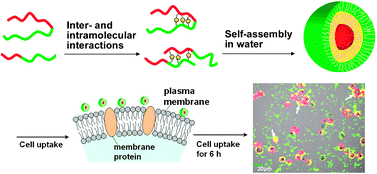Phenylboronic acid-containing block copolymers: synthesis, self-assembly, and application for intracellular delivery of proteins
Abstract
The boronic acid group has been known to bind to sugars and living animal cells. Herein, a novel amphiphilic

* Corresponding authors
a
The Key Laboratory of Functional Polymer Materials of Ministry Education, Institute of Polymer Chemistry, Nankai University, Tianjin, China
E-mail:
zhangxinge@nankai.edu.cn, lcx@nankai.edu.cn
Fax: +86-22-23505598
Tel: +86-22-23501645
The boronic acid group has been known to bind to sugars and living animal cells. Herein, a novel amphiphilic

 Please wait while we load your content...
Something went wrong. Try again?
Please wait while we load your content...
Something went wrong. Try again?
C. Cheng, X. Zhang, Y. Wang, L. Sun and C. Li, New J. Chem., 2012, 36, 1413 DOI: 10.1039/C2NJ20997G
To request permission to reproduce material from this article, please go to the Copyright Clearance Center request page.
If you are an author contributing to an RSC publication, you do not need to request permission provided correct acknowledgement is given.
If you are the author of this article, you do not need to request permission to reproduce figures and diagrams provided correct acknowledgement is given. If you want to reproduce the whole article in a third-party publication (excluding your thesis/dissertation for which permission is not required) please go to the Copyright Clearance Center request page.
Read more about how to correctly acknowledge RSC content.
 Fetching data from CrossRef.
Fetching data from CrossRef.
This may take some time to load.
Loading related content
